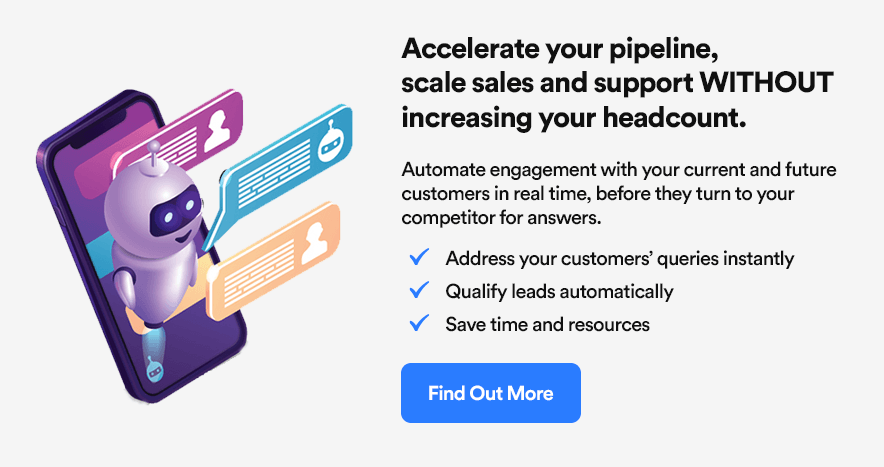

Your Go-To Chatbot Guide 101 - All You Need to Know About Chatbots






2.5 billion – that’s how many customer service hours businesses will save by 2023 through the adoption of chatbots, as estimated by Juniper Research. Chatbot growth, as we are aware, has been phenomenal across industries in the last few years.
Integrating a robust chatbot into your business has become a great way to offer superior customer service, stay ahead of the competition, and increase engagement levels between your brand and your customers.
Here, our chatbot experts discuss all about chatbots – right from what is a chatbot, features that make a chatbot good, to benefits of chatbot, chatbot use-cases, chatbot architecture, and a lot more.
A chatbot is a software program capable of impersonating human conversations in its natural tone, including text or spoken language using technologies such as artificial intelligence (AI), Natural Language Processing (NLP), pattern recognition, etc.
A well-constructed chatbot can effectively address your customers’ queries, thereby helping your business save expenses, automate your lead generation and customer support, and personalize experiences for your customers.
Chatbots are categorized mainly into two different types –
1. Rule-Based Chatbots – They follow a set of pre-defined rules or flows to respond to queries of a user. Most simple applications contain rule-based chatbots, which respond to questions based on the preset rules.
2. AI Chatbots – AI chatbots are more advanced and based on machine learning. AI chatbot uses natural language processing services to understand the meaning behind the questions posed.
Below are some of the essential chatbot features that a good chatbot must have –
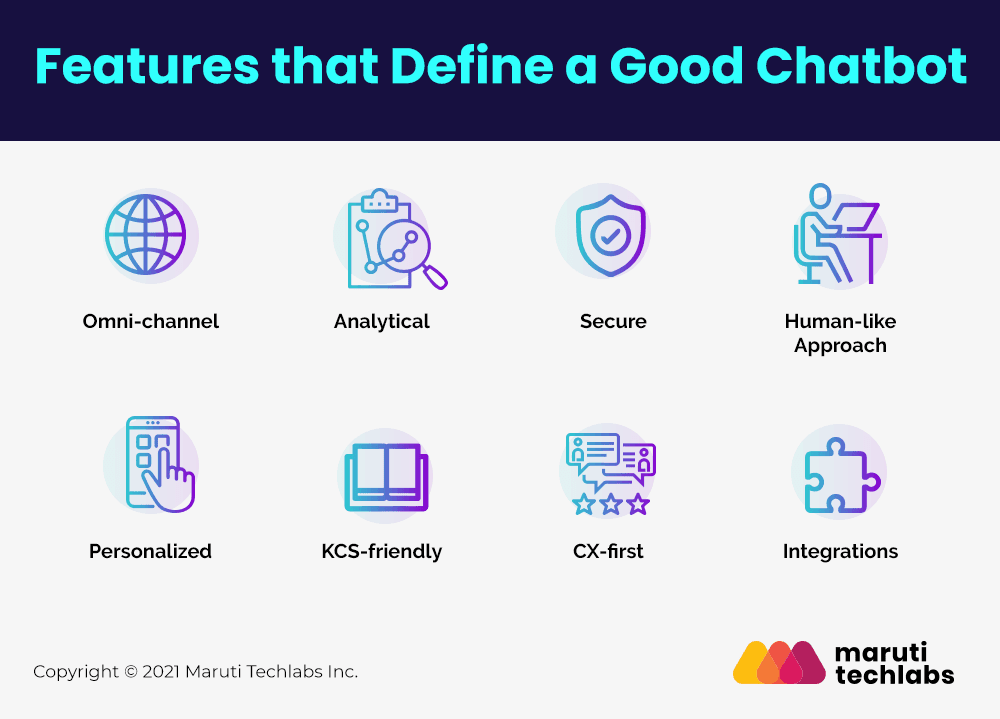
Customers today prefer to conduct business with brands that offer consistent experiences across channels. A good chatbot platform can seamlessly integrate with any communication channels you need, like WhatsApp chatbot, Facebook, SMS, custom mobile apps and websites.
Another crucial chatbot feature is that the chatbot’s performance should be measurable. Chatbot analytics can help your business track the bot’s performance and make changes to the bot accordingly. With metrics like average conversation steps per user, total conversations, top countries, number of returning users, average session duration, etc., you can track goals and build a deeper understanding of your customers.
Security is another very important chatbot feature. Protecting customer privacy and keeping their data secure is a top priority for every business. A good chatbot platform ensures to maintain the highest security standards to keep customers’ data safe.
One of the other noteworthy features of a chatbot is its human-like approach. Like humans, who frequently use context in their day-to-day conversations, a good chatbot has all the information and tools that make it capable of understanding context in open conversations.
The best chatbot platforms are equipped to adjust their tone and language based on user context. For instance, if there is a flight cancellation, the chatbot acknowledges and regrets the inconvenience rather than treating it with nonchalance.
KCS or knowledge-centered service refers to a set of guidelines used for building and preserving organizational knowledge. KCS-friendly bots are made keeping in mind organizational guidelines and turn out to be ethical and helpful.
Chatbots are equipped to prompt users with a variety of relevant options, sometimes based on previous interactions. Further, if the bot cannot handle a complex query, it instantly notifies about the same to a human agent for a smooth customer experience.
Chatbot integration is one of the top decisive chatbot features. With the right chatbot platform, you do not have to worry about switching your existing tools and systems. A chatbot must integrate seamlessly with your existing set of tools.
The working of a chatbot is a fascinating topic. At first, a chatbot can look like a normal app. There is an application layer, a database and APIs to call external services. But in the case of a chatbot, the UI is the chat interface. And to make the chat interface as seamless as possible, a lot of things go on behind the scenes.
Fundamentally, there are three classification methods that are crucial to the chatbot architecture –
For more information on how chatbots process human language, click here to find out how a chatbot works.
The ideal way to identify, analyze, and overcome the challenges related to chatbot implementation is to start by assessing its technical feasibility and then breaking down each process into bite-sized chunks and approach them separately.
Some of the key challenges associated with chatbots and ways to overcome them are listed below –
Robust security is one of the main requirements for any chatbot. Ensure that all the security measures such as end-to-end encryption, two-factor authentication, and authentication timeouts are in place. Additionally, conduct regular and thorough testing of your chatbot by running API security tests and penetration tests.
It is important to highlight the suitability of both these options before making a decision.
For instance, voice-activated chatbots are more suitable for static use and are cross-generational in their approach. They are also more costly to develop and maintain. On the other hand, text-based chatbots are ideal for information-specific responses such as online banking and mobile devices. They are also cheaper to develop and maintain.
To ensure that your users like your chatbot, it is imperative that it’s functional and delivers high-quality and relevant responses. The likability would come in naturally when the chatbot begins to make things easier for your customers and save time.
Among the key elements to get users to like and use your bot include –
a. Usability
b. Functionality
c. Accuracy
d. Trustworthiness
Most of the major obstacles faced while integrating a chatbot into your customer service platforms can be overcome, especially if you partner with a no-code chatbot development platform that can help you build chatbots without writing a single line of code. The right chatbot platform thoroughly understands your needs and can design and build a custom chatbot for your organization accordingly.
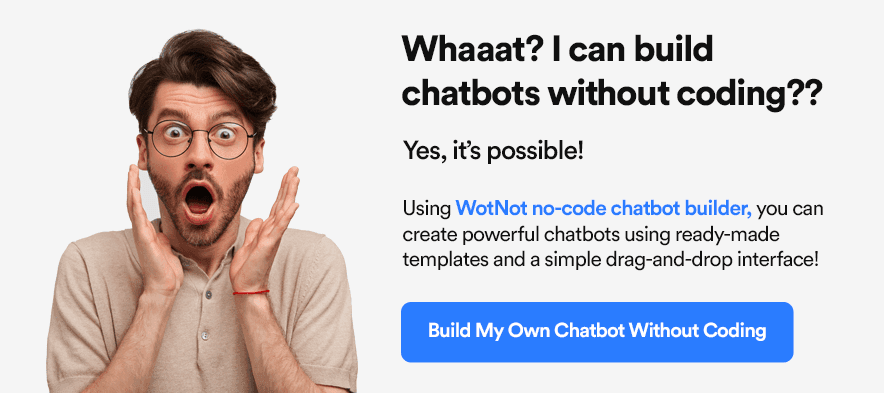
AI chatbots are a gamechanger for organizations looking to intelligently interact with their customers in an automated manner. It reduces the requirement for human resources and dramatically improves efficiency by allowing for a chatbot to handle user’s queries cognitively and reliably.
Essentially, there are three key features that make for an effective AI chatbot–
Click here to learn more about the detailed process of building an intelligent chatbot.
If you are still wondering why chatbots are important, here are top reasons why chatbots can prove to be a boon for your business –
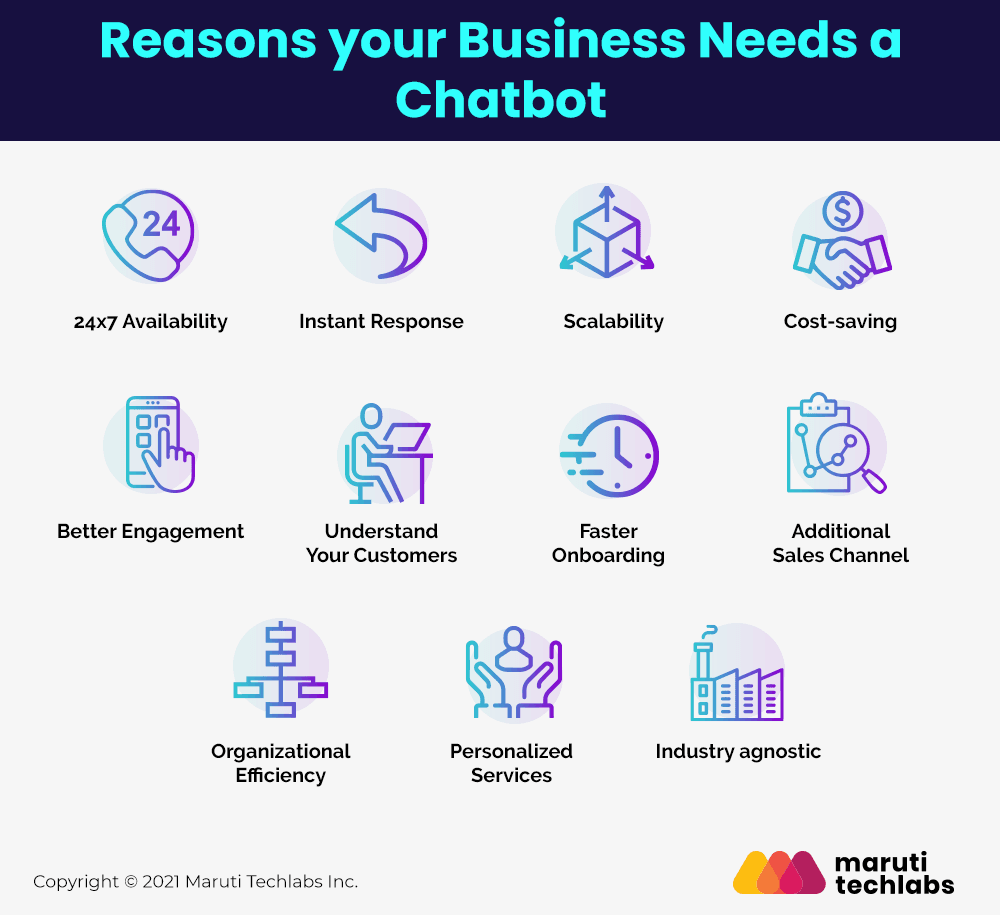
Most businesses today would like to be available for their customers 24×7 but often lack personnel or resources. Chatbots work round-the-clock to answer customer queries even outside of operation hours and solve problems when the support staff can’t.
While customer support staff can concentrate on just one customer at a time, a chatbot can address thousands of customers at the same time. With chatbots, your customers do not need to wait in line to get their queries answered.
Chatbots engage with hundreds of customers at the same time, whereas human agents can only deal with a handful of customers at a given time. Chatbots provide personalized experience to every customer automatically and help scale operational tasks at low maintenance costs.
With chatbots, you do not need to hire multiple agents to answer common customer queries round the clock. Chatbots automate the process, thereby saving cost and time for you. Your support agents can instead focus on more strategic activities like nurturing leads and closing sales.
Chatbots facilitate two-way communication which keeps the customer more engaged. With interactive and personalized experience, your customers feel heard, which in turn increases your brand value and engagement.
Intelligent chatbots can understand your customers better and can also throw in useful suggestions while anticipating their next need. For example, an AI bot can proactively suggest a foreign travel insurance package when booking an international holiday package.
Onboarding both new hires and new users is a strong case in point for why chatbots are important. Chatbots can easily solve FAQs and guide new users through the initial steps of their journeys. Whether it’s a new hire trying to figure out company policies or a new user trying to accomplish first tasks in the product, a chatbot can smoothly guide a user in an interactive manner.
Chatbots serve as an additional sales channel. A good chatbot can effectively qualify prospects and gather basic details. The bot can also be programmed to generate a lead score based on the interaction. Through the lead scores, the sales rep will know which leads are worth nurturing and proceed accordingly.
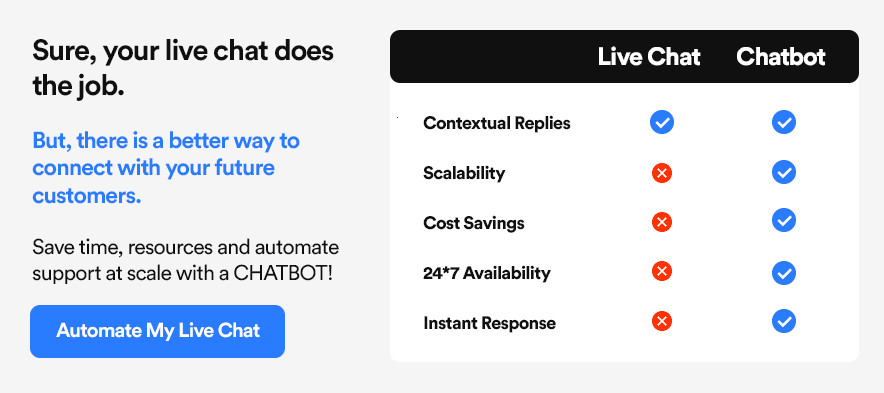
With the ever-rising popularity of messaging and social media platforms, chatbots are central to every brand’s messaging.
There are multiple benefits of implementing chatbots. The key here is how businesses can implement chatbots to enhance their customer experience and gain a competitive advantage.
When creating a chatbot, writing a conversation script that flows naturally is crucial for the design process. Here, let’s discuss the step-by-step process of how to design a chatbot conversation:
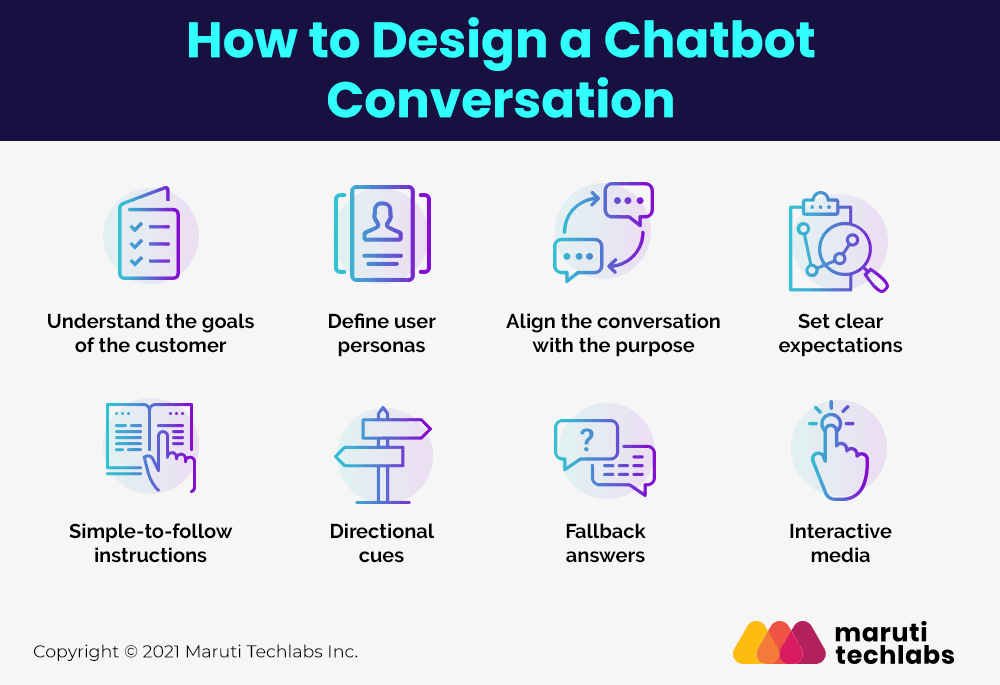
The first step in designing chatbot conversations involves understanding the goals and requirements of the customer. With a wide spectrum of use cases to choose from, it becomes difficult to design a specific goal for chatbots.
Therefore, it is important to define your goal (looking to resolve customer service issues, generate quality leads or promote a new product) and then start to craft your chatbot conversation.
In designing chatbot conversations, you need a thorough understanding of who you are addressing, i.e., user persona. A clear understanding of user personas helps conversation designers empathize with the audience and create a dialogue that will most resonate with them.
Some of the key elements you can focus on when arriving at the user persona include-
a. Demographics – Gender, age, location, marital status, education, income, etc.
b. Psychology – References, goals, motivations, and other similar aspects
In the next step, you need to decide the purpose or use case for your bot and what the bot will help you and your customers accomplish. This could vary from business to business. For instance, a travel and tourism firm could use a bot for providing location or weather forecasting, whereas, in a banking institution, a chatbot will help resolve customer queries and tailor the transactional banking experience.
From the chatbot’s perspective, this kind of industry-specific use case is often called intent. Therefore, the first thing that the chatbot needs to do in a conversation is to recognize the intent. Only when the bot understands the intent, can it deliver the right dialogues to get the tasks done.
Setting clear expectations and letting customers know that they’re chatting with a bot is another important aspect while designing a bot. It is important to make sure that customers understand potential conversation limits. Apart from this, also let customers know how and when they can chat with a real person, whenever required.
Conversational chatbot interface design primarily deals with a conversation, and a good user experience requires simple-to-follow instructions, intuitive interfaces, and maximum similarity to a natural human conversation.
Before designing your bot, think about how you expect the dialogues to flow and solve the customer’s specific problem(s). Additionally, keep the chatbot’s conversation topics simple and close to the areas/subjects it was created to resolve.
While conversing with the audience, your bot should use directional cues and prompts to keep visitors engaged and quickly & efficiently resolve their queries. Directional cues could be in the form of ‘tap to answer’ option buttons, or a list of the same.
The key here is to effectively navigate the challenges in identifying all possible conversation scenarios and defining how your bot handles unclear commands and off-topic queries.
Perfecting the chatbot fallback experience is another important aspect to consider under ‘how to design a chatbot conversation’. Ensure that your chatbot fallback experience offers some kind of value to the user that helps them either gain a better understanding of the chatbot’s scope of knowledge or find the answer they’re looking for.
Some of the examples of the value that support-focused chatbots can offer to the users via the fallback experience include –
a. A follow-up question that assists the user in understanding between closely related intents (Example, “are you looking to upgrade/upgrade your subscription?”).
b. Related search results from different FAQ articles.
c. Offering a reminder to the user about what the chatbot knows and what is out of scope.
d. An option to contact a human.
To make your chatbot more effective, create more compelling messages by including interactive media such as images, emojis, or animated GIFs in your chatbot conversation. It helps bring more personality to your messages and reinforces your messaging, and increases conversation conversion rates.
Although designing a chatbot conversation means much more than what is mentioned in the above checklist, these steps help you in getting started and start approaching the conversational interfaces in the right direction.
Before you begin with the process of chatbot development, you will need to define its scope, understand what you want it to perform, and what are the possible issues you may face before you train your bot to reach its full potential.
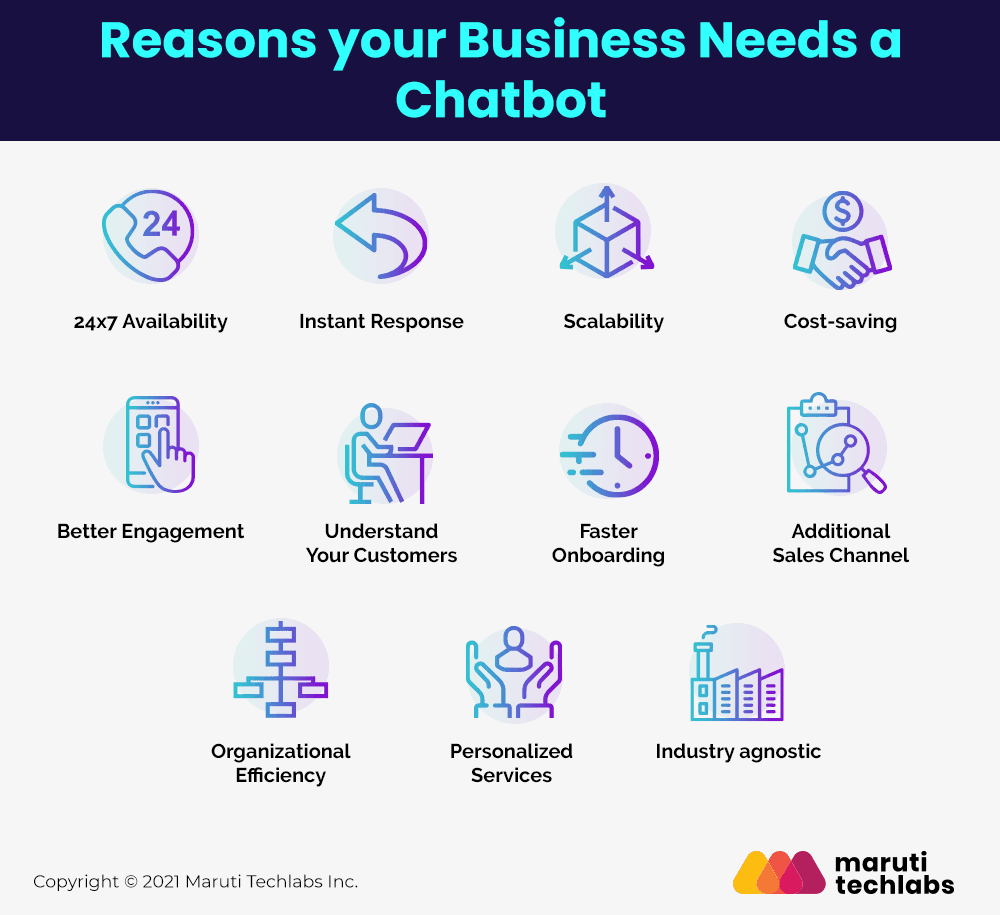
Let’s discuss some of the best practices here to help you in building a chatbot for website or any other platform.
The first question you need to ask during the chatbot development process is why you want to develop the bot. Once you have clarity on this, the next step is to identify your bot’s role and evaluate how it will help you save time, effort and improve efficiency.
The next step is to set up milestones you wish to achieve with your chatbot. This will require input values that will lead to a set of inappropriate outputs. It is always recommended to start with simple goals and gradually move to the more complex ones. These goals and roles can evolve as business needs evolve over the period.
Thoroughly understanding your target audience’s needs and wants is of paramount importance for the success of any chatbot.
Among the key things that you need to know about your customers include the demographics they belong to and the specific kind of questions, they might chat about. It is best to study past customer interactions and accordingly equip your bot to respond to the queries that customers might frequently ask.
There are multiple chatbot deployment platforms available, including Facebook Messenger, WhatsApp chatbot, Kik, Slack, your website, application, SMS, etc. If you are developing a customer-facing chatbot, make sure to deploy it on platforms that your customers already use.
Human beings can ask the same question in different ways. This requires your bot to be intelligent enough to understand the query and provide the appropriate response to the user. Few things that you need to take care of here include –
a. bot should be intelligent enough to solve any query with an accurate response
b. There needs to be a story and flow in the conversation. To enable this, you need to build a context-dependent content model for the conversation that allows your bot to give scalable answers.
Learning from previous interactions with users is another key factor for developing AI-based bots. Past user interactions (if it is not for the first time) can be a great reference point to train the bot. Collecting previous chat data will help your bot intelligently answer whenever posed with any query.
Rigorous testing is another key factor in defining the success of any chatbot. Make sure to have a qualified and diverse team to conduct real-user testing while developing a chatbot.
To reach the highest level of accuracy, you require continuous testing along with the revision of your NLU (Natural language understanding) components. It is important to review these components from time to time so that improvements can be made to make the bot more accurate and interactive.
An end-to-end, build-once-deploy-everywhere development suite, Dialogflow can be used for creating robust conversational interfaces for websites, messaging platforms, mobile apps, and Internet of Things (IoT) devices.
It can be used to build interfaces such as Dialogflow chatbots and interactive voice response (IVR) that enable rich and seamless interactions between your customers and your business.
Here is the detailed procedure for building a Dialogflow chatbot.
There are a lot of different industries using chatbots for different use-cases. Some of these chatbot industries and their applications are listed below-
Chatbots in e-commerce can help organizations scale their operations, save time, boost conversion, shorten sales cycles, and aid in cross-platform performance. In addition to this, chatbots are also language agnostic, allowing e-commerce companies to cater to a truly international audience.
An HR chatbot can handle everything from lead/interest generation and simple screening of applicants to managing background checks and qualifying candidates through the chatbot.
The financial services industry has been one of the early adopters of chatbots. Among the popular use cases for banking include personalized banking, customer support, query resolution, and feedback.
Further, the banking industry also uses chatbots in performing tasks such as employee engagement, IT ticketing, parse messages, contract review and analysis, and password management.
In the healthcare industry, chatbots have been saving a lot of time and resources by assisting doctors with patient progress reports, updating patients with test reports, checking in on post-recoveries, etc.
Education chatbots help educational institutes a great deal – personalizing education, spaced interval learning, student feedback, professor assessment, helping people learn new languages, essay scoring, and completing administrative formalities.
A sales chatbot can help get in touch with website visitors and resolve the questions they may have. Additionally, a sales chatbot can be taught to ask specific sales-oriented questions that get the customer interested in your offerings and lead them to take action in their buyer journey.
From enabling organizations to check inventory levels, allowing customers and suppliers to track the shipment’s present status by simply typing the delivery number to inventory/ supply chain tracking, chatbots have multiple applications in the supply chain industry.
In the hospitality sector, chatbots are working towards offering a better guest service experience and serving as a personal travel assistant or virtual concierge for hospitality brands. Since these chatbots are available 24/7, they allow hospitality businesses to offer a positive experience that builds customer loyalty and satisfaction.
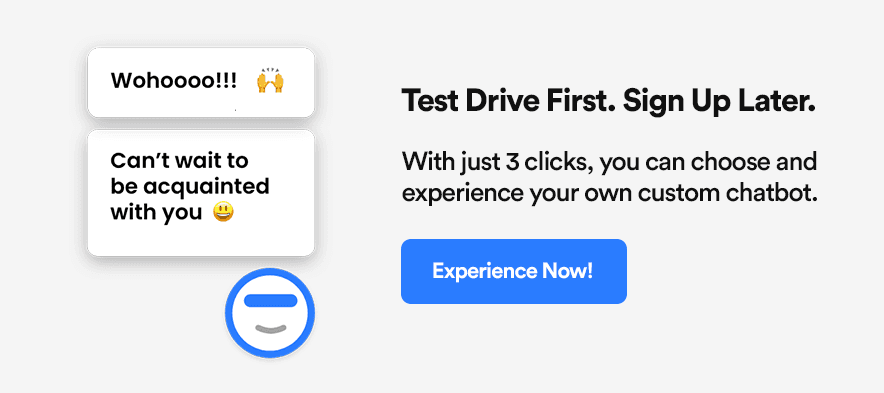
Apart from these, chatbots have various use cases in other industries, including insurance, legal, marketing, airline, manufacturing, and more. Businesses need to find a high-yielding use case specific to their industry that can deliver high ROI.
Chatbots today have become an integral part of our life. Although chatbot technology is still evolving, the wide array of use cases across industries helps both businesses and users handle repetitive and mundane tasks quickly and efficiently.
Their objective is not, and never should be, to entirely replace humans. With their human-like approach and conversational interface, chatbots are here to streamline operations so that they can take care of the repetitive tasks and we humans can be involved more in strategic activities.
The sea of chatbot platforms available in the market today is indicative of the fact that chatbots are more of a necessity to a business than a mere good-to-have add-on. In such a scenario, it becomes even more important to choose the best chatbot development platform that can truly understand your business goals.
If you too are looking to automate your business growth at low maintenance costs and handle mission-critical tasks using effective chatbots, look no further. We, at Maruti Techlabs, have developed chatbots across industries and various use-cases. Known to have built chatbots which yield higher ROIs for our clients, we can help you with your chatbot strategy. Right from evaluating your use-case to designing the chatbot to integrating it with your existing system, we take care of your end-to-end chatbot journey.
To get in touch with us, simply drop us a note here and we’ll get in touch with you.
